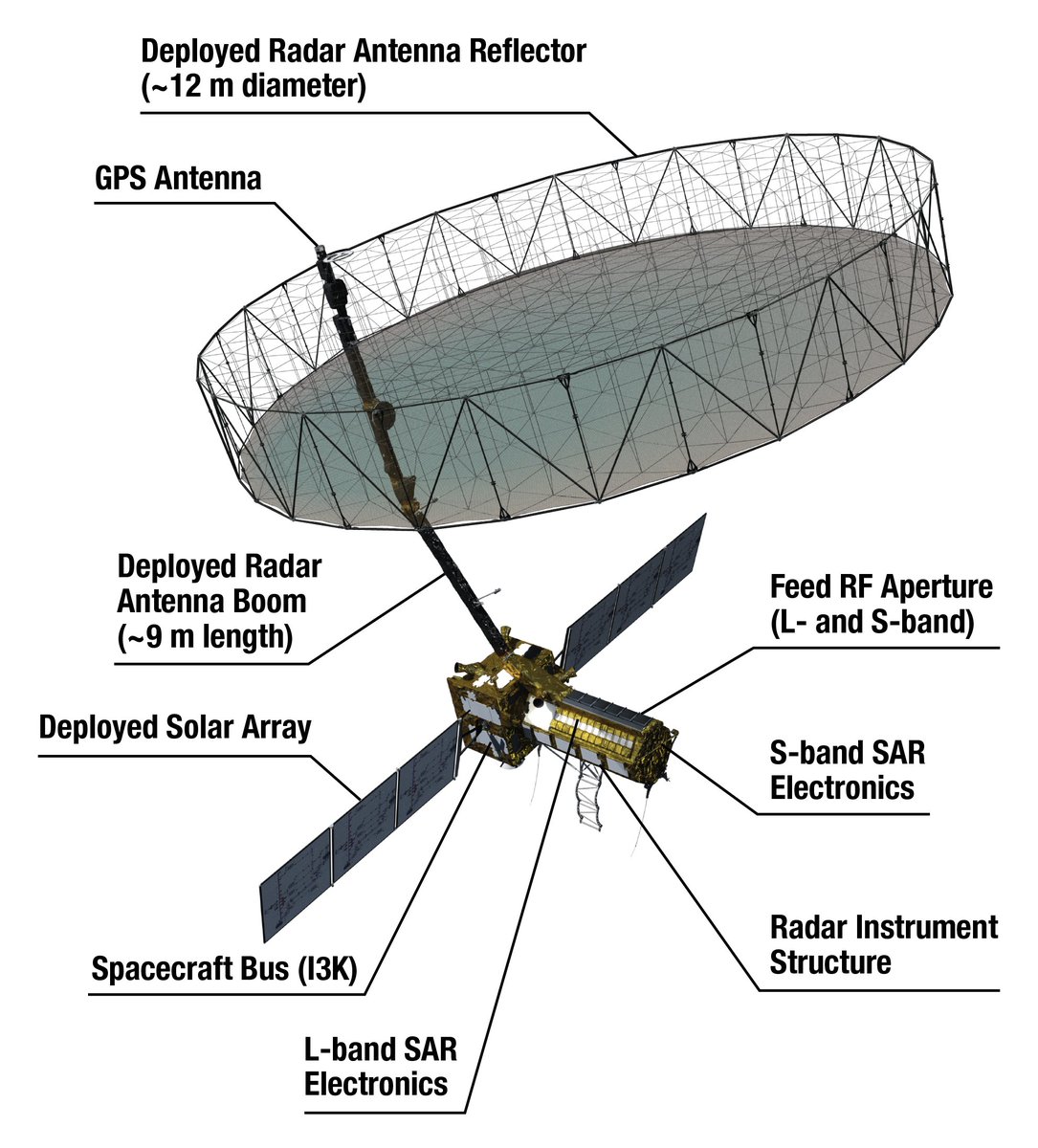
#Thread #Space #UPDATE
@isro has officially said the NASA-Isro SAR (#NISAR), a LEO observatory being jointly developed with @NASA “shall be launched from Indian soil in Q1 of 2024”, and its science operations will begin 90 days after it reaches the intended orbit. 1/n
Pic: JPL
@isro has officially said the NASA-Isro SAR (#NISAR), a LEO observatory being jointly developed with @NASA “shall be launched from Indian soil in Q1 of 2024”, and its science operations will begin 90 days after it reaches the intended orbit. 1/n
Pic: JPL

The synthetic aperture radar (SAR) payloads mounted on integrated radar instrument structure (IRIS) and the spacecraft bus are together called an observatory. 2/n
The observatory will map the entire globe in 12 days & provide spatially & temporally consistent data for understanding changes in Earth’s ecosystems, ice mass, vegetation biomass, sea-level rise, groundwater & natural hazards - earthquakes, tsunamis, volcanoes & landslides. 3/n
“It'll carry L &S dual band SAR — 1st dual frequency radar imaging mission in said bands using advanced Sweep SAR to provide space-borne SAR data with high repeat cycle, high res, & larger swath,” Isro’s dedicated page for #NISAR, which went live late on Feb 3, reads. 4/n
@NASAJPL & @isro are realising the observatory which will not only meet respective national needs but also will feed the science community with data encouraging studies related to surface deformation measurements through repeat-pass InSAR technique, Isro added. 5/n
NASA is responsible for providing the L-Band SAR payload system in which the Isro supplied S-Band SAR payload and both these systems will make use of a large size (about 12m diameter) common unfurlable reflector antenna. 6/n
In addition, NASA would provide engineering payloads for the mission, including a payload data subsystem, high-rate science downlink system, GPS receivers and a solid state recorder. 7/n
Isro is responsible for providing the S-SAR data handling system, high-rate downlink system, spacecraft bus systems, the GSLV launch system and mission operations related services. 8/n
The observatory carries a 12m wide deployable mesh reflector mounted onto a deployable 9m boom developed by JPL which will be used by both the L-Band and S-Band SAR payload systems. 9/n
“The IRIS hosts S-SAR and L-SAR tiles along with their electronics and data handling systems. The spacecraft incorporates all the attitude (orientation) and orbit control elements, power systems, thermal management systems,” Isro added. 10/n
Launch: “The target launch readiness date is January 2024,” Isro said. It encompasses time interval that takes NISAR from ground, encapsulated in launch vehicle fairing… 11/n
…to after separation & ends with the completion of solar array deployment & observatory in an Earth-pointed orientation and in two-way communication with the ground. “The launch sequence is a critical event,” Isro added. 12/n
Commissioning: According to Isro, the first 90 days after launch will be dedicated to commissioning, or in-orbit checkout (IOC), the objective of which is to prepare the observatory for science operations. 13/n
“Commissioning is divided into sub-phases of initial checkout (Isro & JPL engineering payload checkout), spacecraft checkout, instrument checkout. Philosophically, sub-phases are designed as a step-by-step build up in capability to full observatory ops,” says Isro. 14/n
The full observation operations will begin with the physical deployment of all deployable parts (notably the boom and radar antenna, but not including the solar arrays which are deployed during launch phase)... 15/n
…checking out the engineering systems, turning on the radars and testing them independently and then conducting joint tests with both radars operating. 16/n
Science Ops: “Science ops phase begins at the end of commissioning & extends for 3yrs & contains all data collection required to achieve the level-one science objectives… 17/n
…During this phase, the science orbit will be maintained via regular manoeuvres, scheduled to avoid or minimise conflicts with science observations,” Isro said. 18/n
Extensive calibration & validation activities will take place throughout the first 5 months, with yearly updates of 1-month duration. Observation plan for both L&S instruments, along with engineering activities will be generated pre-launch via frequent coordination. n/n
• • •
Missing some Tweet in this thread? You can try to
force a refresh














